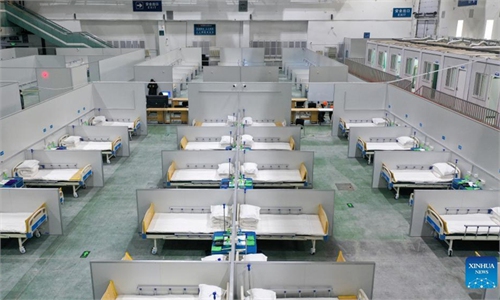China likely to control new wave of local COVID-19 infections by early April: Lanzhou-based epidemic prediction team

Volunteers guide residents for nucleic acid testing in a residential community in Hohhot on Feb 21, 2022.Photo: IC
China should stick to the dynamic zero-case policy and is likely to control this wave of domestic outbreaks by early April with current anti-epidemic measures, a Lanzhou-based epidemic prediction team told the Global Times on Monday.
A securer external environment is a precondition for China to gradually relax COVID-19 epidemic restrictions, but when the global pandemic has yet to be ended in a short term, the country should make full preparations before the gradual relaxation of COVID-19 restrictions, the epidemic prediction team from the collaborative innovation center of western ecological safety affiliated with Lanzhou University, led by Huang Jianping, told the Global Times.
Before the relaxation of COVID-19 restrictions, in the current key period, China can fortify epidemic defense lines across ports, and build epidemic monitoring mechanisms and improve medical mobilization capability, in addition to the research and development of more effective drugs and vaccines to make full preparations, the team said.
The country can explore a more comprehensive scheme for the relaxation of COVID-19 restrictions when the current epidemic can be controlled and the external environment is safer, Huang's team noted.
According to the Global COVID-19 Prediction System developed by Huang's team, under current effective epidemic control measures, this round of domestically-transmitted outbreaks would be controlled in early April 2022 with the cumulative infections reaching 35,000 (between 24,700 and 45,300).
From March 1 till Monday, the mainland registered 5,504 confirmed cases. The team said factors such as highly-contagious Omicron, increasing flow of people during the back-to-school season and people's relaxing mindset during the holiday on epidemic propelled such high number of infections recently.
Based on the current situation, the global pandemic would subside by the end of 2023 with the cumulative number of confirmed COVID-19 cases worldwide reaching 750 million, the Global COVID-19 Prediction System predicted.
While global infections are rising quickly due to highly-contagious Omicron, China should still maintain a dynamic zero case policy while strictly guarding against imported and domestic rebounds, as China cannot take the risk of allowing the general population to contract with the virus, as a larger number of infections leads to more deaths, the expert's team said, adding that the country has made people's health and lives the priority by adopting the dynamic zero case policy.
If China relaxes restrictive policies, an outbreak occurs in the country would lead to more than 10 million infections. China's strategy to prevent the return of a domestic outbreak and imported COVID-19 cases and the dynamic zero-COVID approach are still the best plan to deal with the pandemic, Huang's team previously told the Global Times.
To further reduce the negative impact that epidemic will inflict on the country and people and better cope with future global pandemic, Huang's team suggested strengthening the monitoring capability of virus in the environment and how climate and environment affects the spread of pathogenic microorganism, and establishing a global and regional pre-warning epidemic system.



